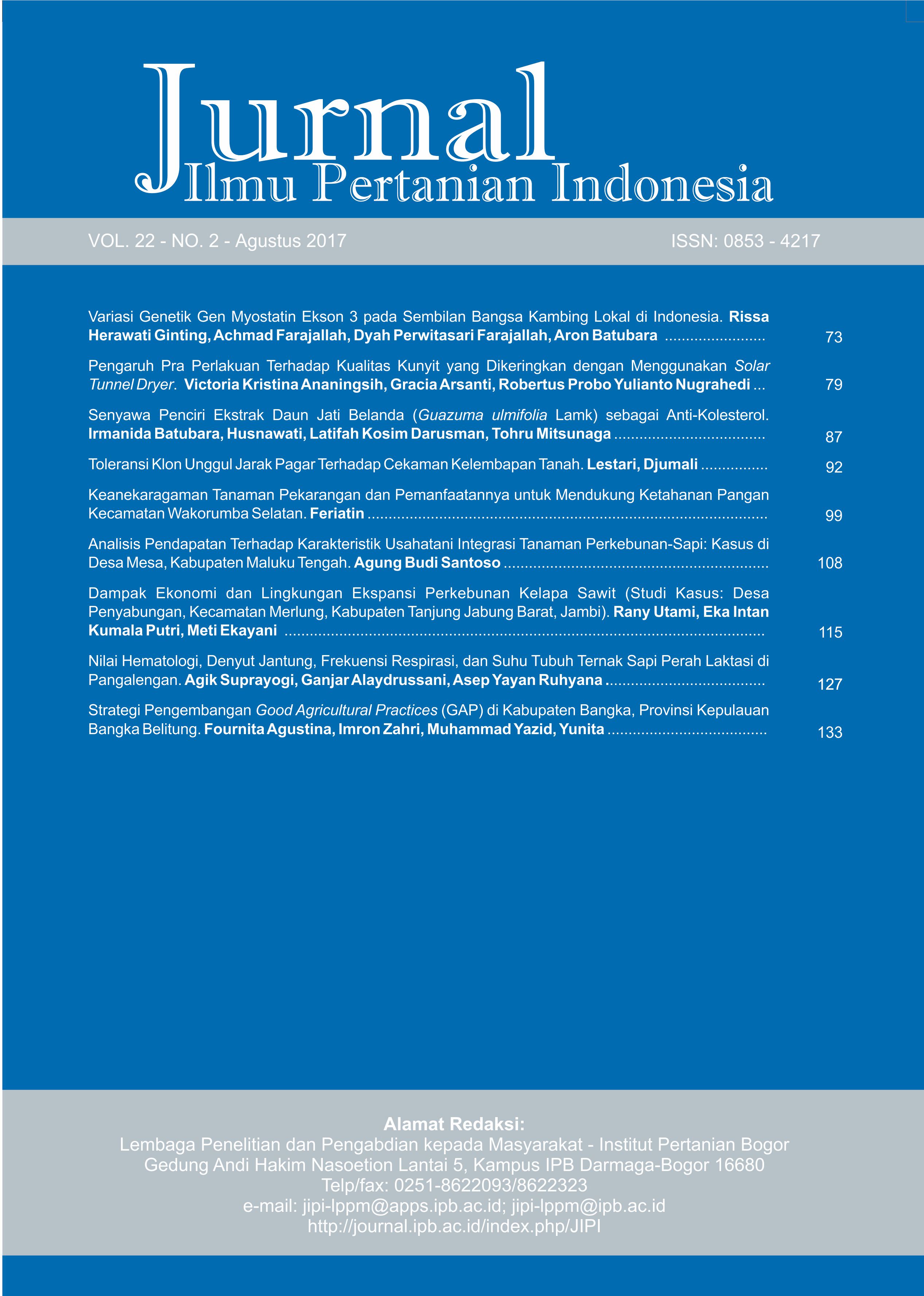Keanekaragaman Tanaman Pekarangan dan Pemanfaatannya untuk Mendukung Ketahanan Pangan Kecamatan Wakorumba Selatan
Abstract
This study aimed to determine the type composition, vegetation structure, and the patterns of utilization to support food security in the sub district of South Wakorumba. This study employed a quadrat method. The results of this research show that the composition of plant species in gardens in South Wakorumba sub district was comprised of 25 families from 44 species of plants. For plants vegetation structure the highest of importance value for trees of the class was indicated by coconut (Cocos nucifera L.) species. Whereas the lowest value was indicated by water apple (Eugenia aquea Burm. F) species. For of poles, the highest of importance value was indicated by chocolate (Theobroma cacao L.) species. Whereas the lowest value was by Jamaica cashew (Syzygium malacensis) species. The class of saplings highest value was indicated by papaya (Carica papaya L.) species. whereas the lowest was indicated by tamarind (Tamarindus indica L.) species. For of seedling the highest of importance value was indicated by coconut (Cocos nucifera L.) species. Whereas the lowest of importance value was indicated by rambutan (Nephelium lappaceum L.) species. The pattern of utilization of garden plants by the villagers of Wakorumba Sub District is as follows: as a source of carbohydrate (18.18%), proteins (11.36%), vitamins (45.45%), minerals (22.73%), and fat (2.27%)Downloads
References
Afandi. 2002. Home Garden: Sebagai Salah Satu Sistem Agroforestry Lokal. Medan (ID): Universitas Islam Sumatra Utara (UISU).
Ashari, Santana, Purwantini TB. 2012. Potensi dan Prospek Pemanfaatan Lahan Pekarangan untuk Mendukung Ketahanan Pangan. Forum Penelitian Agro Ekonomi. 30(1): 13-20.
[BPS] Badan Pusat Statistik. 2013. Kecamatan Wakorumba Selatan Dalam Angka. Muna (ID).
Barbour MG, Burk JH, Pitts WD. 1987. Terrestrial Plant Ecology. Third Edition. California (US): The Benjamin Cumming Publising Company Inc.
Darmawijaya MI. 1997. Klasifikasi Tanah, Dasar Teori bagi Peneliti Tanah dan Pelaksana Pertanian di Indonesia. Yogyakarta (ID): Gadjah Mada University Press.
Hardjosuwarno S. 1989. Dasar-dasar Ekologi Tumbuhan. Yogyakarta (ID): Universitas Gadjah Mada.
Hariyanto S, Irawan B, Soedarti T. 2008. Teori dan Praktek Ekologi. Surabaya (ID): Airlangga University Press.
Indriyanto. 2006. Ekologi Hutan. Jakarta (ID): PT Bumi Aksara.
Kusmana C. 1997. Metode Survey Vegetasi. Bogor(ID): Institut Pertanian Bogor.
Muller-Dumbois D, Ellenberg H. 1974. Aims and Method of Vegetation Ecology. New York (US): John Wiley & Sons.
Novitasari E. 2011. Studi Budidaya Tanaman Pangan di Pekarangan Sebagi Sumber Ketahanan Pangan Keluarga (Studi Kasus di Desa Ampel Gading Kecamatan Tirtoyudo Kabupaten Malang). [Skripsi]. Malang (ID): Universitas Brawijaya.
Pandey CB, Rai RB, Singh L, Singh AK. 2007. Homegardens of Andaman and Nicobar, India. Agricultur System. 2(1-3): 1-22. http://doi.org/dbm72p
Rahayu M, Siagian MH. 1994. Peranan Pekarangan dalam Usaha Meningkatkan Pendapatan Keluarga. Majalah Ilmiah Universitas Widya Gama. 1(3): 19-29.
Rahayu M, Fanani Z. 1996. Pekarangan, dan Pemanfaatannya di Desa Fatum Nasi-TTS, Timor. Prosiding Seminar Ilmiah Nasional Lustrum VIII Fakultas Biologi Universitas Gadjah Mada, Yogyakarta (ID), 18-20 September 1995. Hal: 135-137.
Rahayu M, Prawiroatmodjo S. 2005. Keanekaragaman Tanaman Pekarangan dan Pemanfataannya di Desa Lampeapi Pulau Wawoni Sulawesi Tenggara. Jurnal Teknologi Lingkungan. 6(2): 360-364.
Saliem HP. 2011. Kawasan Rumah Pangan Lestari (KRPL). Makalah di sampaikan pada Konggres Ilmu Pengetahuan Nasional (KIPNAS), Kawasan Rumah Pangan Lestari (KRPL). Jakarta tangal 8-10 November 2011.
Syafei ES. 1990. Pengantar Ekologi Tumbuhan. Bandung (ID): Institut Teknologi Bandung.
This journal is published under the terms of the Creative Commons Attribution-NonCommercial 4.0 International License. Authors who publish with this journal agree to the following terms: Authors retain copyright and grant the journal right of first publication with the work simultaneously licensed under a Creative Commons Attribution-NonCommercial 4.0 International License. Attribution — You must give appropriate credit, provide a link to the license, and indicate if changes were made. You may do so in any reasonable manner, but not in any way that suggests the licensor endorses you or your use. NonCommercial — You may not use the material for commercial purposes.






















